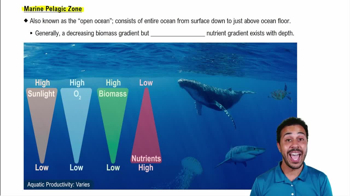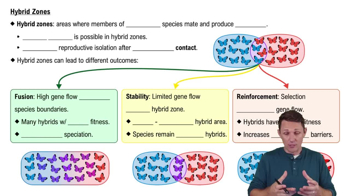Table of contents
- 1. Introduction to Biology2h 40m
- 2. Chemistry3h 40m
- 3. Water1h 26m
- 4. Biomolecules2h 23m
- 5. Cell Components2h 26m
- 6. The Membrane2h 31m
- 7. Energy and Metabolism2h 0m
- 8. Respiration2h 40m
- 9. Photosynthesis2h 49m
- 10. Cell Signaling59m
- 11. Cell Division2h 47m
- 12. Meiosis2h 0m
- 13. Mendelian Genetics4h 41m
- Introduction to Mendel's Experiments7m
- Genotype vs. Phenotype17m
- Punnett Squares13m
- Mendel's Experiments26m
- Mendel's Laws18m
- Monohybrid Crosses16m
- Test Crosses14m
- Dihybrid Crosses20m
- Punnett Square Probability26m
- Incomplete Dominance vs. Codominance20m
- Epistasis7m
- Non-Mendelian Genetics12m
- Pedigrees6m
- Autosomal Inheritance21m
- Sex-Linked Inheritance43m
- X-Inactivation9m
- 14. DNA Synthesis2h 27m
- 15. Gene Expression3h 20m
- 16. Regulation of Expression3h 31m
- Introduction to Regulation of Gene Expression13m
- Prokaryotic Gene Regulation via Operons27m
- The Lac Operon21m
- Glucose's Impact on Lac Operon25m
- The Trp Operon20m
- Review of the Lac Operon & Trp Operon11m
- Introduction to Eukaryotic Gene Regulation9m
- Eukaryotic Chromatin Modifications16m
- Eukaryotic Transcriptional Control22m
- Eukaryotic Post-Transcriptional Regulation28m
- Eukaryotic Post-Translational Regulation13m
- 17. Viruses37m
- 18. Biotechnology2h 58m
- 19. Genomics17m
- 20. Development1h 5m
- 21. Evolution3h 1m
- 22. Evolution of Populations3h 52m
- 23. Speciation1h 37m
- 24. History of Life on Earth2h 6m
- 25. Phylogeny2h 31m
- 26. Prokaryotes4h 59m
- 27. Protists1h 12m
- 28. Plants1h 22m
- 29. Fungi36m
- 30. Overview of Animals34m
- 31. Invertebrates1h 2m
- 32. Vertebrates50m
- 33. Plant Anatomy1h 3m
- 34. Vascular Plant Transport2m
- 35. Soil37m
- 36. Plant Reproduction47m
- 37. Plant Sensation and Response1h 9m
- 38. Animal Form and Function1h 19m
- 39. Digestive System10m
- 40. Circulatory System1h 57m
- 41. Immune System1h 12m
- 42. Osmoregulation and Excretion50m
- 43. Endocrine System4m
- 44. Animal Reproduction2m
- 45. Nervous System55m
- 46. Sensory Systems46m
- 47. Muscle Systems23m
- 48. Ecology3h 11m
- Introduction to Ecology20m
- Biogeography14m
- Earth's Climate Patterns50m
- Introduction to Terrestrial Biomes10m
- Terrestrial Biomes: Near Equator13m
- Terrestrial Biomes: Temperate Regions10m
- Terrestrial Biomes: Northern Regions15m
- Introduction to Aquatic Biomes27m
- Freshwater Aquatic Biomes14m
- Marine Aquatic Biomes13m
- 49. Animal Behavior28m
- 50. Population Ecology3h 41m
- Introduction to Population Ecology28m
- Population Sampling Methods23m
- Life History12m
- Population Demography17m
- Factors Limiting Population Growth14m
- Introduction to Population Growth Models22m
- Linear Population Growth6m
- Exponential Population Growth29m
- Logistic Population Growth32m
- r/K Selection10m
- The Human Population22m
- 51. Community Ecology2h 46m
- Introduction to Community Ecology2m
- Introduction to Community Interactions9m
- Community Interactions: Competition (-/-)38m
- Community Interactions: Exploitation (+/-)23m
- Community Interactions: Mutualism (+/+) & Commensalism (+/0)9m
- Community Structure35m
- Community Dynamics26m
- Geographic Impact on Communities21m
- 52. Ecosystems2h 36m
- 53. Conservation Biology24m
48. Ecology
Introduction to Ecology
Problem 11a
Textbook Question
Which of the following sea creatures might be described as a pelagic animal of the aphotic zone? a. a coral reef fish b. an intertidal snail c. a deep-sea squid d. a harbor seal
 Verified step by step guidance
Verified step by step guidance1
Identify the meaning of 'pelagic' and 'aphotic zone'. Pelagic refers to organisms that live in the open sea, away from the coast and the ocean bottom. The aphotic zone is the part of the ocean where sunlight does not reach, making it perpetually dark.
Analyze each option to determine if it fits the criteria of being pelagic and residing in the aphotic zone. Start with option a: Coral reef fish typically inhabit shallow waters near coral reefs in the photic zone where sunlight is available.
Consider option b: Intertidal snails are found in the intertidal zone, which is the area between high tide and low tide; thus, they are neither pelagic nor in the aphotic zone.
Evaluate option c: Deep-sea squids are known to inhabit deep ocean waters, often in the aphotic zone, and are pelagic as they live in the open ocean.
Review option d: Harbor seals are generally found in coastal waters and on shores, not in the open ocean or the aphotic zone.
Recommended similar problem, with video answer:
 Verified Solution
Verified SolutionThis video solution was recommended by our tutors as helpful for the problem above
Video duration:
2mPlay a video:
Was this helpful?
Key Concepts
Here are the essential concepts you must grasp in order to answer the question correctly.
Pelagic Zone
The pelagic zone refers to the open ocean area that is not near the coast or the sea floor. It is divided into different layers based on depth, with the aphotic zone being the deepest part where sunlight does not penetrate. Organisms in this zone have adapted to survive in complete darkness and often rely on bioluminescence or other means to find food.
Recommended video:
Guided course

Marine Pelagic Zone
Aphotic Zone
The aphotic zone is the layer of the ocean that is below the photic zone, where light is insufficient for photosynthesis. This zone typically starts at depths of around 200 meters and extends to the ocean floor. Organisms living in the aphotic zone, such as certain species of squid, have adaptations for low-light conditions and often feed on detritus or other deep-sea creatures.
Recommended video:

Hybrid Zones
Marine Adaptations
Marine adaptations are the physiological and behavioral traits that enable organisms to survive in their aquatic environments. For pelagic animals, these adaptations may include streamlined bodies for efficient swimming, specialized feeding mechanisms, and reproductive strategies suited for life in open water. Understanding these adaptations is crucial for identifying which sea creatures inhabit specific ocean zones.
Recommended video:
Guided course

Marine Pelagic Zone

 2:54m
2:54mWatch next
Master What is Ecology? with a bite sized video explanation from Jason Amores Sumpter
Start learningRelated Videos
Related Practice































































































